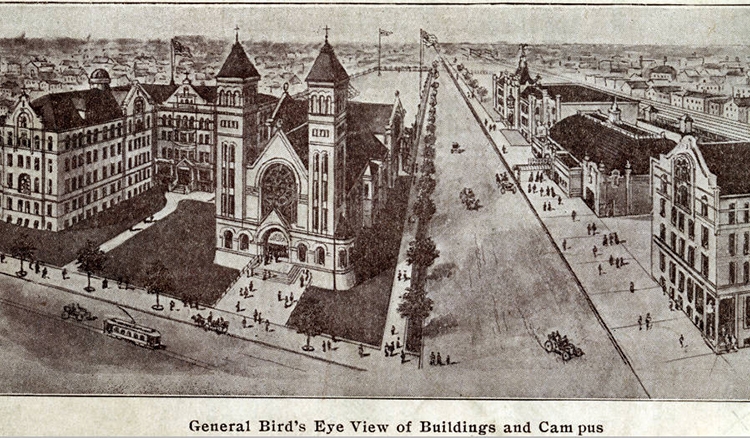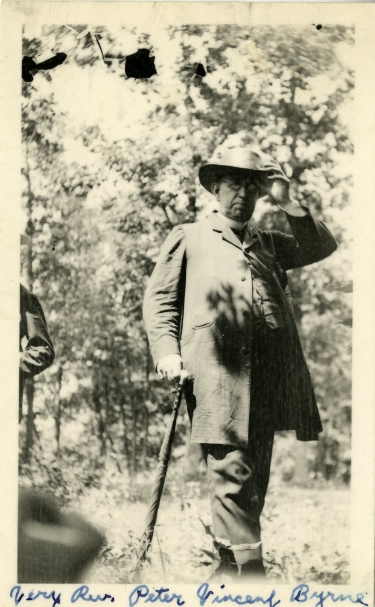 A 1908 aerial view of DePaul University's Lincoln Park campus looking north from the corner of Webster and Sheffield Avenues. Byrne Hall, named for DePaul's first president the Very Reverend Peter V. Byrne, C.M.; the Administration Building; and St. Vincent's Church are seen in the foreground. (DePaul University/Special Collections and Archives)
A 1908 aerial view of DePaul University's Lincoln Park campus looking north from the corner of Webster and Sheffield Avenues. Byrne Hall, named for DePaul's first president the Very Reverend Peter V. Byrne, C.M.; the Administration Building; and St. Vincent's Church are seen in the foreground. (DePaul University/Special Collections and Archives)
January at DePaul marks a time of new beginnings. The possibilities of a new calendar year and a new quarter leave many in the DePaul community looking towards the future. Long before the implementation of the quarter system, however, there was one group of DePaul students and faculty who found themselves considering a quite momentous future. As the school, then called St. Vincent's College, had just opened for classes in September of 1898, the faculty and students present in January of 1899 were the first the school had ever had. Jan. 2, 1899 brought in both the new year and a new president: The Reverend Peter V. Byrne, the first president of St. Vincent's College and, subsequently, DePaul University.
During his ten years as president, Father Byrne would expand St. Vincent's College both physically, adding multiple new buildings to the campus, and academically, adding multiple new programs and courses of study. These actions led to what would ultimately be the most profound achievement of his tenure: the creation of DePaul itself.
Peter Vincent Byrne was born on June 24, 1846 in County Carlo, Ireland. At age 16, he followed his brothers to the United States, settling in New York. While attending Our Lady of the Angels Seminary - now Niagara University - as a secular student, he met the Vincentian fathers and became a novitiate in 1864. He was ordained in 1869 and remained at Our Lady of the Angels for his first assignment, teaching English and Latin. Over the first 30 years of his career, Father Byrne would serve in a variety of posts: at St. Joseph's Church in New Orleans, where he administered to victims of the yellow fever epidemic; St. Vincent's Church in Philadelphia, St. Vincent's College in Cape Girardeau; and Kenrick Seminary in St. Louis.
 The Very Reverend Peter V. Byrne, C.M. (DePaul University/Special Collections and Archives)
The Very Reverend Peter V. Byrne, C.M. (DePaul University/Special Collections and Archives)Father Byrne had returned to St. Joseph's as superior and pastor when he was appointed pastor of St. Vincent's Church and president of St. Vincent's College in Chicago. He assumed the presidency on Jan. 2, 1899 and served until 1909. During his tenure, Father Byrne demonstrated a ceaseless amount of activity and dedication to the growth of the school. Following an influx of Catholic schools in Chicago, St. Vincent's College found that its enrollment had dropped to 130 students. Byrne knew that the only way for the school to survive was to incorporate as a university. Thus, he set out on a plan to expand the school in every way necessary, He added multiple buildings to the campus, including the Administration Building, the Academy Building - now Byrne Hall the Lyceum, and College Theater - known better as "The Barn". Knowing that the school's survival also depended on competing with the secular public universities, Father Byrne decided to expand the curriculum. He added departments of mechanical, electrical, and civil engineering; as well as courses in biology and medical sciences in order to prepare students for medical school.
From there, Father Byrne joined with two Vincentian supporters, Thomas O'Neil Finney, C.M. and Justin A. Nuelle, C.M., and three prominent Chicago attorneys, Judge Walter J. Gibbons, John McGillen, and William Dillon, and set out to re-charter St. Vincent's College as a university. Using the University of Chicago's charter as a guide, the group made the decisions to have both Vincentians and laypersons on the board of trustees and to allow admission to non-Catholic students, both practices that were highly unusual for Catholic universities at the time. Together, the group decided on a new name for the school, and petitioned Illinois Secretary of State James A. Rose to re-charter St. Vincent's College as DePaul University. The state of Illinois granted their request on Dec. 24, 1907.
Though Father Byrne's work would eventually lead to the largest Catholic university in the United States, at the time it was a financial disaster. After years of tireless attempts to rectify DePaul's financial situation to no avail, Father Byrne resigned as president on May 1, 1909. He travelled to Perryville, Missouri, where he taught at St. Mary of the Barren's Seminary until 1918. Father Byrne would remain at St. Mary of the Barren's until his death on July 15, 1932.
Following Father Byrne's death, "The DePaulia" wrote, "He gave DePaul the will to go forward that has characterized its history." Father Byrne's record shows this to be true. In his tireless pursuits to improve DePaul and ensure its survival, Father Byrne set an example that DePaul's subsequent presidents would follow. Because of Father Byrne, DePaul now has a long-standing legacy of dedication to the improvement of the university and, therefore, to the students it sends into the world.